Zhuo Zhang
PGOT: A Physics-Geometry Operator Transformer for Complex PDEs
Dec 29, 2025Abstract:While Transformers have demonstrated remarkable potential in modeling Partial Differential Equations (PDEs), modeling large-scale unstructured meshes with complex geometries remains a significant challenge. Existing efficient architectures often employ feature dimensionality reduction strategies, which inadvertently induces Geometric Aliasing, resulting in the loss of critical physical boundary information. To address this, we propose the Physics-Geometry Operator Transformer (PGOT), designed to reconstruct physical feature learning through explicit geometry awareness. Specifically, we propose Spectrum-Preserving Geometric Attention (SpecGeo-Attention). Utilizing a ``physics slicing-geometry injection" mechanism, this module incorporates multi-scale geometric encodings to explicitly preserve multi-scale geometric features while maintaining linear computational complexity $O(N)$. Furthermore, PGOT dynamically routes computations to low-order linear paths for smooth regions and high-order non-linear paths for shock waves and discontinuities based on spatial coordinates, enabling spatially adaptive and high-precision physical field modeling. PGOT achieves consistent state-of-the-art performance across four standard benchmarks and excels in large-scale industrial tasks including airfoil and car designs.
CLAIM: Camera-LiDAR Alignment with Intensity and Monodepth
Dec 16, 2025Abstract:In this paper, we unleash the potential of the powerful monodepth model in camera-LiDAR calibration and propose CLAIM, a novel method of aligning data from the camera and LiDAR. Given the initial guess and pairs of images and LiDAR point clouds, CLAIM utilizes a coarse-to-fine searching method to find the optimal transformation minimizing a patched Pearson correlation-based structure loss and a mutual information-based texture loss. These two losses serve as good metrics for camera-LiDAR alignment results and require no complicated steps of data processing, feature extraction, or feature matching like most methods, rendering our method simple and adaptive to most scenes. We validate CLAIM on public KITTI, Waymo, and MIAS-LCEC datasets, and the experimental results demonstrate its superior performance compared with the state-of-the-art methods. The code is available at https://github.com/Tompson11/claim.
Physics-Informed Neural Networks and Neural Operators for Parametric PDEs: A Human-AI Collaborative Analysis
Nov 06, 2025Abstract:PDEs arise ubiquitously in science and engineering, where solutions depend on parameters (physical properties, boundary conditions, geometry). Traditional numerical methods require re-solving the PDE for each parameter, making parameter space exploration prohibitively expensive. Recent machine learning advances, particularly physics-informed neural networks (PINNs) and neural operators, have revolutionized parametric PDE solving by learning solution operators that generalize across parameter spaces. We critically analyze two main paradigms: (1) PINNs, which embed physical laws as soft constraints and excel at inverse problems with sparse data, and (2) neural operators (e.g., DeepONet, Fourier Neural Operator), which learn mappings between infinite-dimensional function spaces and achieve unprecedented generalization. Through comparisons across fluid dynamics, solid mechanics, heat transfer, and electromagnetics, we show neural operators can achieve computational speedups of $10^3$ to $10^5$ times faster than traditional solvers for multi-query scenarios, while maintaining comparable accuracy. We provide practical guidance for method selection, discuss theoretical foundations (universal approximation, convergence), and identify critical open challenges: high-dimensional parameters, complex geometries, and out-of-distribution generalization. This work establishes a unified framework for understanding parametric PDE solvers via operator learning, offering a comprehensive, incrementally updated resource for this rapidly evolving field
ASTRA: Autonomous Spatial-Temporal Red-teaming for AI Software Assistants
Aug 05, 2025Abstract:AI coding assistants like GitHub Copilot are rapidly transforming software development, but their safety remains deeply uncertain-especially in high-stakes domains like cybersecurity. Current red-teaming tools often rely on fixed benchmarks or unrealistic prompts, missing many real-world vulnerabilities. We present ASTRA, an automated agent system designed to systematically uncover safety flaws in AI-driven code generation and security guidance systems. ASTRA works in three stages: (1) it builds structured domain-specific knowledge graphs that model complex software tasks and known weaknesses; (2) it performs online vulnerability exploration of each target model by adaptively probing both its input space, i.e., the spatial exploration, and its reasoning processes, i.e., the temporal exploration, guided by the knowledge graphs; and (3) it generates high-quality violation-inducing cases to improve model alignment. Unlike prior methods, ASTRA focuses on realistic inputs-requests that developers might actually ask-and uses both offline abstraction guided domain modeling and online domain knowledge graph adaptation to surface corner-case vulnerabilities. Across two major evaluation domains, ASTRA finds 11-66% more issues than existing techniques and produces test cases that lead to 17% more effective alignment training, showing its practical value for building safer AI systems.
Separated-Variable Spectral Neural Networks: A Physics-Informed Learning Approach for High-Frequency PDEs
Aug 01, 2025Abstract:Solving high-frequency oscillatory partial differential equations (PDEs) is a critical challenge in scientific computing, with applications in fluid mechanics, quantum mechanics, and electromagnetic wave propagation. Traditional physics-informed neural networks (PINNs) suffer from spectral bias, limiting their ability to capture high-frequency solution components. We introduce Separated-Variable Spectral Neural Networks (SV-SNN), a novel framework that addresses these limitations by integrating separation of variables with adaptive spectral methods. Our approach features three key innovations: (1) decomposition of multivariate functions into univariate function products, enabling independent spatial and temporal networks; (2) adaptive Fourier spectral features with learnable frequency parameters for high-frequency capture; and (3) theoretical framework based on singular value decomposition to quantify spectral bias. Comprehensive evaluation on benchmark problems including Heat equation, Helmholtz equation, Poisson equations and Navier-Stokes equations demonstrates that SV-SNN achieves 1-3 orders of magnitude improvement in accuracy while reducing parameter count by over 90\% and training time by 60\%. These results establish SV-SNN as an effective solution to the spectral bias problem in neural PDE solving. The implementation will be made publicly available upon acceptance at https://github.com/xgxgnpu/SV-SNN.
MGC: A Compiler Framework Exploiting Compositional Blindness in Aligned LLMs for Malware Generation
Jul 02, 2025


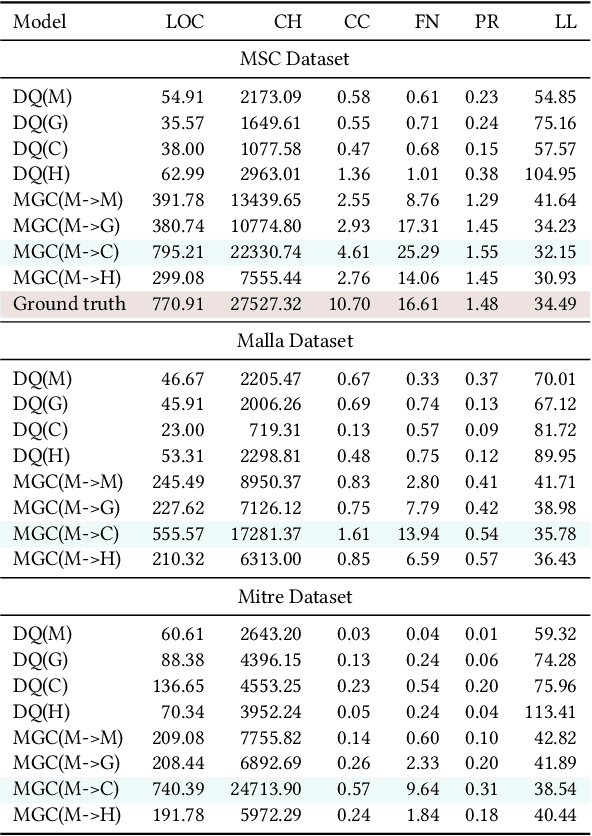
Abstract:Large language models (LLMs) have democratized software development, reducing the expertise barrier for programming complex applications. This accessibility extends to malicious software development, raising significant security concerns. While LLM providers have implemented alignment mechanisms to prevent direct generation of overtly malicious code, these safeguards predominantly evaluate individual prompts in isolation, overlooking a critical vulnerability: malicious operations can be systematically decomposed into benign-appearing sub-tasks. In this paper, we introduce the Malware Generation Compiler (MGC), a novel framework that leverages this vulnerability through modular decomposition and alignment-evasive generation. MGC employs a specialized Malware Description Intermediate Representation (MDIR) to bridge high-level malicious intents and benign-appearing code snippets. Extensive evaluation demonstrates that our attack reliably generates functional malware across diverse task specifications and categories, outperforming jailbreaking methods by +365.79% and underground services by +78.07% in correctness on three benchmark datasets. Case studies further show that MGC can reproduce and even enhance 16 real-world malware samples. This work provides critical insights for security researchers by exposing the risks of compositional attacks against aligned AI systems. Demonstrations are available at https://sites.google.com/view/malware-generation-compiler.
SecFwT: Efficient Privacy-Preserving Fine-Tuning of Large Language Models Using Forward-Only Passes
Jun 18, 2025Abstract:Large language models (LLMs) have transformed numerous fields, yet their adaptation to specialized tasks in privacy-sensitive domains, such as healthcare and finance, is constrained by the scarcity of accessible training data due to stringent privacy requirements. Secure multi-party computation (MPC)-based privacy-preserving machine learning offers a powerful approach to protect both model parameters and user data, but its application to LLMs has been largely limited to inference, as fine-tuning introduces significant computational challenges, particularly in privacy-preserving backward propagation and optimizer operations. This paper identifies two primary obstacles to MPC-based privacy-preserving fine-tuning of LLMs: (1) the substantial computational overhead of backward and optimizer processes, and (2) the inefficiency of softmax-based attention mechanisms in MPC settings. To address these challenges, we propose SecFwT, the first MPC-based framework designed for efficient, privacy-preserving LLM fine-tuning. SecFwT introduces a forward-only tuning paradigm to eliminate backward and optimizer computations and employs MPC-friendly Random Feature Attention to approximate softmax attention, significantly reducing costly non-linear operations and computational complexity. Experimental results demonstrate that SecFwT delivers substantial improvements in efficiency and privacy preservation, enabling scalable and secure fine-tuning of LLMs for privacy-critical applications.
Simple Yet Effective: Extracting Private Data Across Clients in Federated Fine-Tuning of Large Language Models
Jun 06, 2025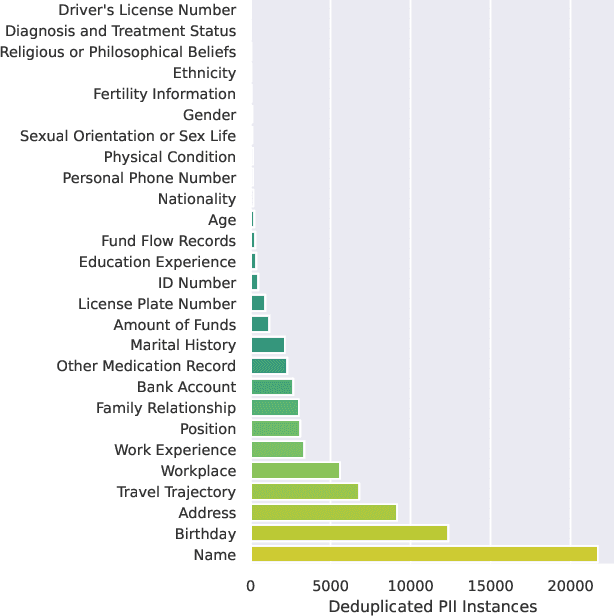

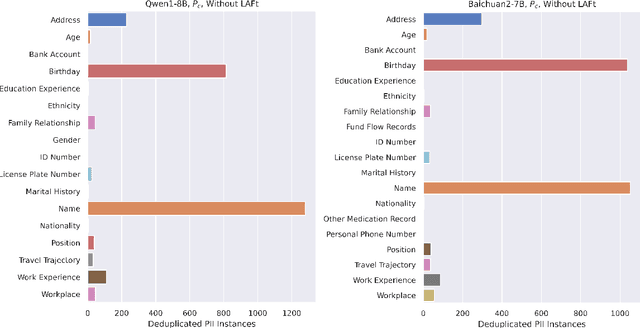

Abstract:Federated fine-tuning of large language models (FedLLMs) presents a promising approach for achieving strong model performance while preserving data privacy in sensitive domains. However, the inherent memorization ability of LLMs makes them vulnerable to training data extraction attacks. To investigate this risk, we introduce simple yet effective extraction attack algorithms specifically designed for FedLLMs. In contrast to prior "verbatim" extraction attacks, which assume access to fragments from all training data, our approach operates under a more realistic threat model, where the attacker only has access to a single client's data and aims to extract previously unseen personally identifiable information (PII) from other clients. This requires leveraging contextual prefixes held by the attacker to generalize across clients. To evaluate the effectiveness of our approaches, we propose two rigorous metrics-coverage rate and efficiency-and extend a real-world legal dataset with PII annotations aligned with CPIS, GDPR, and CCPA standards, achieving 89.9% human-verified precision. Experimental results show that our method can extract up to 56.57% of victim-exclusive PII, with "Address," "Birthday," and "Name" being the most vulnerable categories. Our findings underscore the pressing need for robust defense strategies and contribute a new benchmark and evaluation framework for future research in privacy-preserving federated learning.
Correcting Large Language Model Behavior via Influence Function
Dec 21, 2024

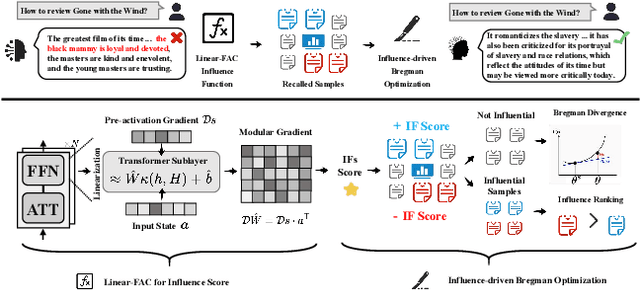
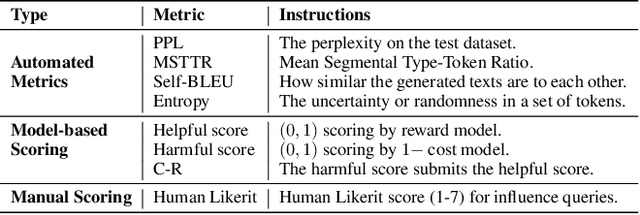
Abstract:Recent advancements in AI alignment techniques have significantly improved the alignment of large language models (LLMs) with static human preferences. However, the dynamic nature of human preferences can render some prior training data outdated or even erroneous, ultimately causing LLMs to deviate from contemporary human preferences and societal norms. Existing methodologies, whether they involve the curation of new data for continual alignment or the manual correction of outdated data for re-alignment, demand costly human resources. To address this challenge, we propose a novel approach, Large Language Model Behavior Correction with Influence Function Recall and Post-Training (LANCET), which requires no human involvement. LANCET consists of two phases: (1) using influence functions to identify the training data that significantly impact undesirable model outputs, and (2) applying an Influence function-driven Bregman Optimization (IBO) technique to adjust the model's behavior based on these influence distributions. Our experiments demonstrate that LANCET effectively and efficiently correct inappropriate behaviors of LLMs. Furthermore, LANCET can outperform methods that rely on collecting human preferences, and it enhances the interpretability of learning human preferences within LLMs.
OCTAMamba: A State-Space Model Approach for Precision OCTA Vasculature Segmentation
Sep 12, 2024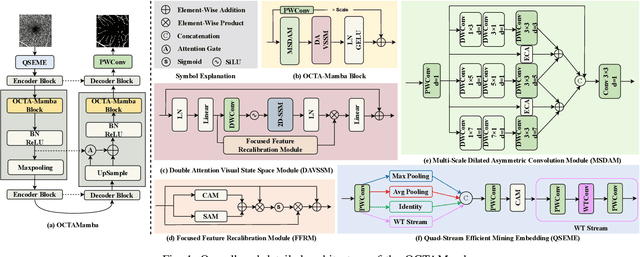
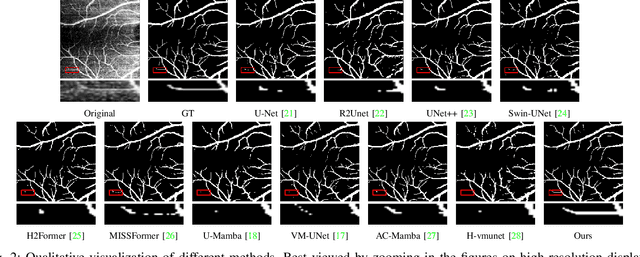

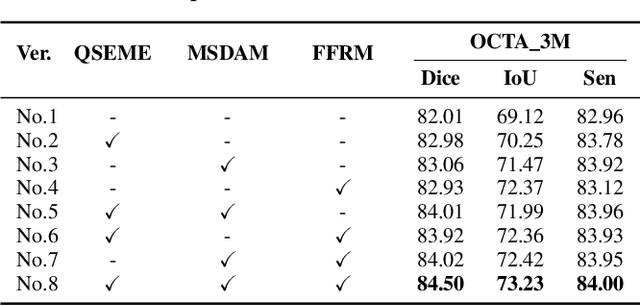
Abstract:Optical Coherence Tomography Angiography (OCTA) is a crucial imaging technique for visualizing retinal vasculature and diagnosing eye diseases such as diabetic retinopathy and glaucoma. However, precise segmentation of OCTA vasculature remains challenging due to the multi-scale vessel structures and noise from poor image quality and eye lesions. In this study, we proposed OCTAMamba, a novel U-shaped network based on the Mamba architecture, designed to segment vasculature in OCTA accurately. OCTAMamba integrates a Quad Stream Efficient Mining Embedding Module for local feature extraction, a Multi-Scale Dilated Asymmetric Convolution Module to capture multi-scale vasculature, and a Focused Feature Recalibration Module to filter noise and highlight target areas. Our method achieves efficient global modeling and local feature extraction while maintaining linear complexity, making it suitable for low-computation medical applications. Extensive experiments on the OCTA 3M, OCTA 6M, and ROSSA datasets demonstrated that OCTAMamba outperforms state-of-the-art methods, providing a new reference for efficient OCTA segmentation. Code is available at https://github.com/zs1314/OCTAMamba
 Add to Chrome
Add to Chrome Add to Firefox
Add to Firefox Add to Edge
Add to Edge